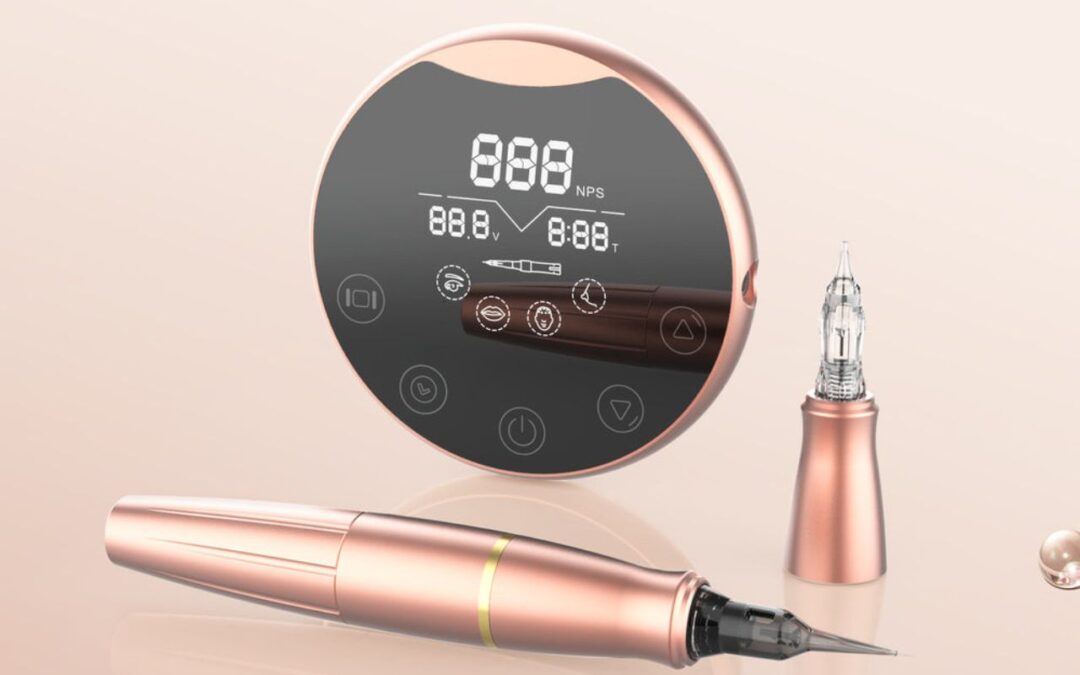In today’s beauty industry, permanent makeup (PMU) services are experiencing unprecedented demand, offering lucrative opportunities for skilled practitioners. However, many aspiring artists find their creative potential constrained by subpar equipment that fails to deliver precise, natural-looking results.
The key to elevating your permanent makeup career lies in mastering permanent makeup tattoo device kit that enables superior technical execution and consistent outcomes.
Premium permanent makeup equipment serves as the cornerstone of professional success, bridging the gap between artistic vision and flawless implementation. Whether you’re performing microblading, powder brows, or lip blush procedures, the right tools can dramatically enhance your precision, efficiency, and client satisfaction.
This comprehensive guide will explore essential PMU equipment components, machine selection criteria, pigment optimization techniques, proper handling methods, and crucial sterilization protocols – everything you need to transform your permanent makeup practice from basic to exceptional.
Essential PMU Equipment Components Explained
Professional permanent makeup artistry demands a sophisticated array of precision tools working in harmony. At the core lies the permanent makeup machine, available in two primary configurations.
Rotary machines utilize a rotating motor to drive the needle, offering smooth, consistent strokes ideal for shading and filling. Pen machines, like those from Biomaser, deliver rapid, precise movements perfect for fine lines and detailed work. Understanding these fundamental differences enables artists to select the optimal tool for each procedure.
Every professional kit requires specialized components beyond the machine itself. Quality needle cartridges come in various configurations – from single-point for hairlike strokes to multiple-point clusters for shading. Ergonomic grips provide essential control while reducing hand fatigue during lengthy procedures. Responsive foot pedals allow seamless speed adjustments, and reliable power supplies ensure consistent performance throughout treatments.
Core PMU Supplies Breakdown
Pigment selection represents a critical decision point, with organic formulations offering gentle application and natural aging characteristics, while inorganic options provide enhanced color stability and longevity. The choice depends heavily on client skin type, desired outcome, and procedure location.
Proper sterilization demands medical-grade barriers, EPA-registered disinfectants, and single-use components to maintain strict hygiene standards. Supporting tools complete the professional setup, including calibrated pigment racks for organized workflow, sterile mixing bowls for precise color customization, and specialized calibration tools to ensure optimal machine performance.
Selecting High-Performance PMU Machines
When evaluating permanent makeup machines, three critical performance factors demand attention. First, torque consistency ensures steady needle movement regardless of skin resistance, preventing patchy results. The machine should maintain stable power output even during extended sessions.
Second, advanced vibration control protects both artist and client comfort while enabling precise strokes. Third, adjustable speed ranges between 6,000-12,000 RPM accommodate different procedures and skin types.
Premium machines distinguish themselves through thoughtful engineering. Optimal weight distribution, typically between 110-140 grams, reduces hand fatigue during long sessions. Ergonomic grip designs featuring textured surfaces and anatomically correct angles support natural hand positioning. Low operational noise (under 55 decibels) helps maintain a professional atmosphere and reduces client anxiety.
Application-Specific Machine Recommendations
Microblading procedures require machines with precise needle control and minimal vibration for creating hair-like strokes, while powder brow techniques benefit from devices offering variable speed control for seamless shading. Leading manufacturers offer specialized machines starting at professional grade levels with adjustable stroke lengths between 0-2.5mm.
Lip blush procedures demand machines with gentle needle action to prevent trauma on sensitive tissue, typically operating at lower speeds of 6,000-8,000 RPM. Eyeliner work requires ultra-precise machines with exceptional stability features and needle depths restricted to 0.5-1.5mm. Scalp micropigmentation calls for specialized machines capable of rapid needle movement (up to 150 strikes per second) and consistent dot placement.
Optimizing Pigment Ink Results
Successful permanent makeup procedures rely heavily on proper pigment selection and handling. Understanding undertone theory is crucial – warm undertones require yellow-based pigments, while cool undertones need blue-based options to achieve natural-looking results.
When correcting previous work, complementary colors on the color wheel guide neutralization choices: green-based pigments correct redness, while salmon tones counteract unwanted blue or gray.
Achieving optimal pigment consistency requires precise technique. Before each procedure, perform a viscosity test by placing a small amount on the back of a gloved hand – the pigment should maintain its shape without excessive spreading. For thicker formulations, use sterile saline or approved diluting solution in minimal increments until reaching ideal flow characteristics. Mix thoroughly using sterile tools, testing after each adjustment to prevent over-dilution.
Proper storage dramatically impacts pigment longevity and safety. Store bottles upright in a temperature-controlled environment between 65-75°F (18-24°C), away from direct sunlight and heat sources.
Once opened, mark containers with the date and dispose of unused portions after six months. Never mix old and new pigments or transfer between containers to maintain sterility. Regular inventory checks help identify expired products and ensure optimal performance during procedures.
Mastering Equipment Handling Techniques
Proper machine setup forms the foundation of successful PMU procedures. Begin by thoroughly sanitizing your workspace and laying out components in order of use.
When assembling, secure the grip firmly while maintaining sterility, then attach the needle cartridge using a twisting motion until you hear a distinct click. Load pigments into sterile cups immediately before use, avoiding overfilling to prevent contamination. Position your power supply within easy reach but away from potential contamination zones.
Achieving optimal hand control requires consistent practice. Master the pen grip technique by holding the machine at a 45-degree angle, using your pinky finger as a stabilizer against the client’s skin. Practice maintaining steady pressure through controlled hand movements, starting with paper templates before progressing to practice skins. Focus on developing muscle memory for different stroke patterns while maintaining consistent depth.
Troubleshooting Common Equipment Issues
When encountering inconsistent pigment flow, first check needle depth settings and ensure proper cartridge installation. If stuttering occurs, inspect the power supply connection and verify voltage settings match manufacturer specifications. For persistent issues, clean the machine’s internal components following the manufacturer’s guidelines.
To address needle drag and skin trauma, adjust your hand speed and machine frequency to work in harmony. Start with lower speeds around 6,000 RPM for sensitive areas, gradually increasing based on skin response.
Patchy saturation often results from inconsistent needle depth or pressure – maintain steady hand movement while keeping the machine perpendicular to the skin’s surface. Implement a weekly maintenance schedule including thorough cleaning, connection testing, and calibration checks to prevent performance issues before they arise.
Sterilization Protocols for PMU Supplies
Implementing rigorous sterilization protocols safeguards both practitioner and client safety while ensuring regulatory compliance. Begin each procedure by sanitizing all work surfaces with hospital-grade disinfectant, maintaining a designated clean zone separate from procedure areas.
Set up barriers using medical-grade plastic wrapping on frequently touched surfaces including machine cords, power supplies, and work lamps. Don fresh PPE including gloves, masks, and protective eyewear before handling any sterilized equipment.
For reusable components, autoclave sterilization provides the highest level of pathogen elimination. Process items at 270°F (132°C) for 15 minutes under 15 PSI pressure, using sterilization pouches with indicator strips to verify proper processing.
Cold sterilization offers an alternative for heat-sensitive items – submerge thoroughly cleaned tools in EPA-registered high-level disinfectant for the manufacturer-specified contact time, typically 8-10 hours. Maintain detailed sterilization logs documenting dates, methods, and verification results.
Prevent cross-contamination through systematic workflow organization. Establish clear boundaries between clean and contaminated zones using color-coded containers. Never reuse single-use items like needle cartridges or pigment cups.
Document client-specific sterilization protocols in detailed procedure notes, including lot numbers of sterilized items and verification results. Regular staff training on updated sterilization guidelines ensures consistent implementation of safety protocols across all procedures.
Elevating Your PMU Practice Through Professional Equipment
The journey to PMU mastery begins with investing in professional-grade equipment that enables precise, consistent results. By understanding and implementing proper machine selection, pigment optimization, handling techniques, and sterilization protocols, practitioners can dramatically elevate their technical capabilities and artistic outcomes.
Premium equipment serves not just as tools, but as extensions of artistic vision, allowing for the intricate detail work and natural-looking results that distinguish elite PMU artists.
Success in permanent makeup requires a strategic approach to equipment investment, prioritizing essential components that directly impact procedure quality and client satisfaction. As the industry continues to evolve, maintaining a commitment to technical excellence through professional-grade tools becomes increasingly crucial.
By viewing premium equipment as a foundation for growth rather than an expense, practitioners position themselves for long-term success in this dynamic field. Remember, your artistic potential can only be fully realized when supported by tools that match your dedication to excellence.






